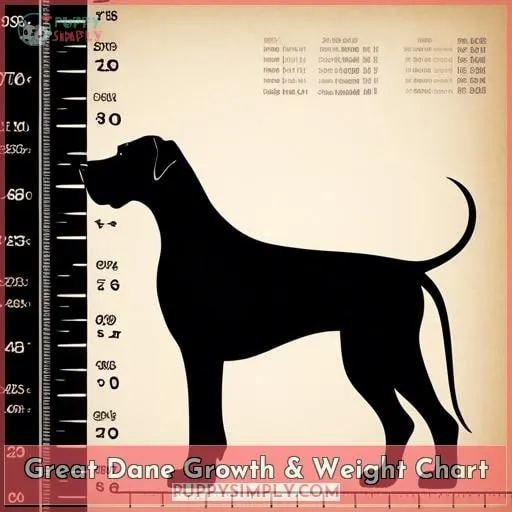This site is supported by our readers. We may earn a commission, at no cost to you, if you purchase through links.
 Hold on to your hats! Great Danes are one of the largest breeds out there, and they grow incredibly fast.
Hold on to your hats! Great Danes are one of the largest breeds out there, and they grow incredibly fast.
Our comprehensive guide provides all the answers you need in order to make sure your Great Dane pup grows up happy and healthy! From an average growth rate chart for both weight and height milestones, advice on regular vet check-ups as well as preventive measures for joint issues or health conditions; our great dane growth chart has everything covered.
Plus we answer those burning questions: How much bigger will my puppy get? What is considered a healthy weight for a Great Dane? And more!
Table Of Contents
- Key Takeaways
- Great Dane Growth & Weight Chart
- At What Age is a Great Dane Full Grown?
- How Big Should a 6-month-old Great Dane Be?
- How Much Bigger Will My Great Dane Get?
- What is the Size of a Full-grown Great Dane?
- How Do I Make Sure My Great Dane is Healthy?
- My Great Dane is Small, Should I Be Concerned?
- At What Age Will a Great Dane Stop Growing?
- What is Considered a Healthy Weight for a Great Dane?
- Conclusion
Key Takeaways
- Great Danes have a remarkably fast growth rate, equivalent to 14 human years in one dog year.
- Full-grown size is typically attained by the age of 18 months, with growth plate closure occurring between 18-24 months.
- Male Great Danes stand 30-32 inches tall and weigh between 140-175 pounds, while females are 28-30 inches tall and weigh around 110-140 pounds.
- Key weight milestones include birth (1-2 lbs), 2 months (15-30 lbs), 6 months (65-100 lbs), and 1 year (95-140+ lbs).
Great Dane Growth & Weight Chart
Are you considering getting a Great Dane? If so, it’s important to understand the growth and weight milestones of this breed. The average growth rate for a Great Dane is equivalent to 14 human years in one year, and full-grown size is achieved by 18 months.
Keeping track of these factors will help ensure healthy development for your pet.
Growth and Weight Milestones
You can track your pup’s growth with a Great Dane Growth & Weight Chart, which outlines key milestones to look for at different ages. Monitor their weight progression, watch for growth plate closure, and provide nutritional support as needed.
Be aware of gender differences in size and monitor exercise levels accordingly. With this chart, you can assess if they are on track or may need additional care.
The chart outlines important weight milestones like birth (1-2 lbs), 2 months (15-30 lbs), 6 months (65-100 lbs), and 1 year (95-140+ lbs). Also, be sure to take into account genetics, environment, and neutering when considering an adult Great Dane’s expected size range.
Males typically form 30–32 inches tall and weigh 140–175 pounds, while females are usually 28–30 inches tall and weigh 110–140 pounds.
Keep up with regular vet checkups so that any health concerns are addressed early on to ensure healthy growth throughout adulthood!
Average Growth Rate
Averaging up to two inches per month, you can expect your Great Dane’s growth rate to be swift. Factors influencing this include genetics, nutrition, and environment. During their first year of life, they experience rapid growth spurts at 4-6 months.
By 18 months, they will reach full height, but muscle development continues for another 2 years.
Gender differences also play a role in their growth. Males typically reach a height of 30-32 inches and weigh 140-175 pounds when fully grown. Females, on the other hand, are usually 28-30 inches tall and weigh 110-140 pounds.
It’s important to note that growth plate closure occurs between 18-24 months. Therefore, proper nutrition is crucial during the puppy stage as well as adulthood to ensure healthy growth in large breed dogs like the Great Dane.
| Height (in) | Weight (lb) | Age (mo) |
|---|---|---|
| 1 – 2 | 15 – 30 | 2 |
| 0 | — | — |
| 6 | 9 | 85 |
| 100 | 12 | 95 |
| 140 |
At What Age is a Great Dane Full Grown?
At 18-24 months, these gentle giants reach their full size—an awe-inspiring milestone! While male Great Danes are typically 30-32 inches tall and 140 to 175 pounds, females range from 28 to 30 inches tall and 110 to 140 pounds.
Genetics and environment can influence the size of a fully grown Dane. Growth plate closure is responsible for height growth while muscle development continues until 2 years old.
Oversized paws can be an indication of ongoing growth during this stage too. Great Danes’ individual growth rates vary with some reaching full maturity earlier or later than average; consult a vet if there are any concerns regarding your pup’s progress along the Great Dane growth chart.
Gender differences also play into overall size: males tend to be larger than females in both height and weight categories when looking at the Great Dane height chart.
Even though variations in final adult sizes may occur, it’s important that you monitor your puppy’s health throughout its life as part of a normal pet care routine so they stay within healthy weight ranges outlined by veterinarians on the Great Dane size charts for each gender type when fully grown age is reached.
How Big Should a 6-month-old Great Dane Be?
Now that you know the approximate age when a Great Dane is full grown, let’s look at how big it should be at 6 months old.
At this point in its puppyhood stages, your pup will experience one of its largest growth spurts and could weigh anywhere between 65-100 pounds.
To ensure healthy development during these formative months, there are some key milestones to monitor such as:
- Paw size: Oversized paws indicate ongoing growth and can help gauge progress against average Great Dane sizes.
- Weight management: Follow your vet’s feeding advice to prevent overfeeding, which may lead to joint problems or hip dysplasia later on in life.
- Muscle development: Nurturing muscle strength through exercise helps maximize their potential adult weight, but keep sessions short due to rapid energy expenditure at this stage of the life cycle.
By monitoring paw size and weight gain while providing an active lifestyle for your pup, you can rest assured that it will reach up to 95-140 lbs by 1 year old—right where it should be!
How Much Bigger Will My Great Dane Get?
As you monitor your Great Dane’s growth, you may be wondering how much bigger they’ll get. Predicting the size of a full-grown adult Great Dane can be difficult due to genetic influences and environmental factors that affect their overall rate of growth.
To gain an idea of what to expect in terms of physical health and correct weight, monitoring changes in the following areas is essential:
- Growth spurt timing
- Genetic size influences
- Nutrition’s impact on growth
- Physical health considerations
- Vet-recommended feeding advice
Knowing these details will help predict how much bigger your pup will get as it matures into adulthood. Additionally, tracking its development through regular vet checkups helps ensure proper nutrition and healthy skeletal development – ultimately leading to a longer lifespan for your beloved companion.
What is the Size of a Full-grown Great Dane?
You can expect your Great Dane to reach an impressive height of 30-32 inches for males and 28-30 inches for females when fully grown. Genetics, nutrition, environment, and exercise will all play a role in the size of your adult Great Dane.
Proper nutrition is important as it influences both skeletal development and growth plate impact, which affects overall size.
Gender differences are also significant, with male adults being heavier than female adults by up to 35 pounds due to its larger frame structure. Genetic health issues such as bloat or cardiomyopathy should be monitored closely through regular vet visits throughout their lifetime (8 – 10 years).
With proper care, diet, exercise, and veterinary checkups, you’ll have no trouble keeping track of your pet’s development so that you can enjoy the presence of a full-grown Great Dane within 2 years!
How Do I Make Sure My Great Dane is Healthy?
Ensuring the health of your Great Dane is essential for their well-being and longevity. To achieve this, preventive measures should be taken to address joint issues and other health conditions that may arise.
Regular vet check-ups are also important in order to monitor growth progress and development.
Preventive Measures for Joint Issues and Health Conditions
To ensure your Great Dane’s health, take preventive measures for joint issues and other common conditions. Supplement their diet with joint supplements recommended by a veterinarian to help support healthy joints as they age.
Incorporate an exercise regimen based on the growth plate care guidelines provided by canine specialists. Follow nutritional guidelines to keep them within a healthy weight range, and monitor bloat prevention tips to prevent this potentially fatal condition from occurring.
Also, consider hip dysplasia prevention methods such as purebred dog care and injury prevention techniques that will reduce the risk of developing orthopedic diseases or injuries later in life due to rapid growth during puppyhood or adolescence – the Great Dane growth chart helps track development over time!
Regular vet check-ups provide a comprehensive evaluation of your pet’s overall physical condition so you can address any potential problems before they become serious illnesses. Be sure to also take note of common conditions like thyroid issues for early detection and treatment if necessary.
Importance of Regular Vet Check-ups
Regular vet visits are essential for tracking your Great Dane’s development and ensuring a long, healthy life. Vet consultations provide an opportunity to monitor growth, assess health status, and discuss preventative measures.
Through regular veterinary care, growth can be monitored over time. Developmental milestones can be identified, and a plan of action is formulated in the event of any health issues or concerns arising.
It is important to take into consideration the effects of neutering on growth plates when planning regular appointments with your vet.
Overall, regular vet check-ups can help ensure the overall health of your Great Dane. By assessing growth through a Great Dane growth chart, you can reduce the likelihood of unexpected problems related to health issues or other illnesses caused by poor nutrition or lack of exercise/preventative care from neutering effects.
When it comes time for that next check-up, make sure you ask questions about how best you can ensure a long and healthy future for your beloved companion!
My Great Dane is Small, Should I Be Concerned?
If your Great Dane is smaller than expected, it could be cause for concern as size differences can indicate underlying health issues. Growth variation in a Great Dane puppy may point to an unhealthy development or nutrition problem that needs further investigation.
Monitor their growth patterns and consult with your vet if you have any worries about their size.
The table below details the average weight range of full-grown male and female adult Danes compared to the stages of growth:
| Age | Female (lbs) | Male (lbs) | Height (inches) |
|---|---|---|---|
| Birth | 1 – 2 | 1 – 2 | N/A |
0 months – 15–30 lbs;
6 months – 65–100 lbs;
12 months – 95–140 lbs;
Adult – 110 – 140 pounds, 28-30 inches tall, 140-175 pounds, 30—32 inches tall.
Nutrition is key for healthy development, so ensure they are fed according to age guidelines from established pet food brands or under veterinary advice. Puppy training should begin early too while monitoring behavior changes due to hormone fluctuations during puberty, which occurs around 4 — 6 months old.
It’s important also to watch out for signs such as limping, difficulty breathing, etc., indicating potential health issues like joint problems, hip dysplasia, hypothyroidism, bloat, etc. Taking preventive measures by getting appropriate pet insurance coverage ensures comprehensive veterinary care when needed.
At What Age Will a Great Dane Stop Growing?
Generally, a Great Dane’s growth rate slows down and stops at around 18-24 months old. Growth plate closure is when the bones stop growing, and this is usually seen between 6 to 12 months of age in Great Danes.
After they have stopped growing, it’s important for them to still receive daily exercise as this helps with muscle development and keeps their joints healthy.
The timing of growth spurts can also vary depending on gender. Males tend to grow faster than females, but both will reach full height by 18 months old or sooner if neutered early enough.
Nutrition plays an important role in a pup’s overall size, so it’s essential that they are fed high-quality food appropriate for their stage of life during all stages before adulthood, including puppyhood, adolescence (4-6 months), and adulthood (18+).
Overfeeding should be avoided since doing so can cause excessive weight gain, which puts strain on developing bones, leading to joint issues later in life like hip dysplasia or arthritis.
Monitoring your pup’s growth through regular vet checkups will help ensure he/she reaches full health potential following set milestones from the Great Dane growth chart guideline.
What is Considered a Healthy Weight for a Great Dane?
You’ll be amazed by the size of your Great Dane, so it’s important to understand what constitutes a healthy weight. A male adult should weigh between 140 and 175 pounds, while females typically range from 110 to 140 pounds.
Genetics and environment can influence this somewhat, as well as neutering, which may affect growth plates in puppies.
It is important to maintain an ideal weight for your pet with nutritional guidelines such as high-quality proteins, omega fatty acids, vitamins, and minerals. Plus, regular exercise requirements like two hours a day for these giants! Any excess food will lead to obesity-related health issues over time that could shorten their lifespan or cause other serious complications not covered by dog health insurance.
Great Danes have an average life expectancy of 8-10 years but could live 6-7 due to various factors, including dieting and exercise habits throughout their lifetime.
Conclusion
The Great Dane Growth Chart is a crucial tool for owners who want to ensure their pet’s healthy development. This majestic breed is full of heart and loyalty and can make a wonderful companion with the right care and nutrition.
Knowing the milestones and average growth rate can help you determine if your pup is developing as expected.
They should reach full-grown size by 18-24 months, and the average weight is between 140-170 lbs. Regular vet check-ups and preventive measures are essential for managing any joint issues or health conditions.
With a proper diet and exercise, your Great Dane can live a happy and healthy life.















